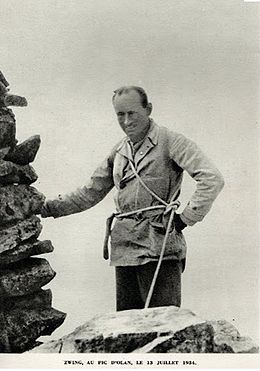In Rennes there is really an alpine club (see their website). But very few in the Breton capital know the alpinist Léon Zwingelstein. In the winter of 1933 he had carried out alone the ski raid “Grenoble-Nice-Chamonix-Zermatt-Tyrol-Brigue” and many other expeditions that still deserve a lot of respect today.
Born in Rennes on October 16, 1898, little Léon was the fifth of a litter of seven children. “He spent his youth in a large wealthy Protestant family,” wrote Jean-Pierre Barbier, in the review The mountains and mountaineering. “Loving the outdoors, he is one of the scouts. Serious and applied student, he follows his scientific studies and here he is with a degree. “
Son of an industrial tanner
But what is less known is that he was the son of Charles who, with his brother Georges and his father Laurent, ran one of the most important tanneries in Brittany. This company has been recognized nationally and worldwide for the quality of its production. The company was also awarded a gold medal at the Turin International Exhibition in 1911. Its leathers from China were highly valued.
But let’s get back to the topic! In 1913 he lost his father and, in 1917, he enlisted in the infantry in Rennes. After a year of training, he got to know the front and on 17 August 1918 he was transferred to the military hospital in Dijon. “We will never know what young people like us have suffered in this turmoil; young people like us, too used to the comfort of a home. War… ”(quoted by Jacques Dierteten in The Chemineau des Montagnes)
In December 1918, Léon joined the Rennes barracks to be demobilized in May 1920. In Grenoble, where he studied engineering, he met Jean-Paul Loustalot, a pupil of his own school. Start with his friend he competes in the mountains. “In the spring of 1922 they made progress in climbing,” wrote Jacques Dierteten. Both accomplish some feats during the ascents of the Virgin to Mont Aiguille (June 1922) and Pierra Menta (July 1922). “While climbing, the soul also rises, detaching itself from all that is low and from all that is ugly …”, repeated the mountaineer.
After graduating in engineering, the young man returns to the West, but the call of the mountains is stronger. He moved to Lyon and then to Grenoble. After the death of his friend Loustalot, he made the first winter ascent of Râteau in 1930. “One fine day he returned to Rennes where he thought he had found a situation worthy of him. But it’s still a failure. “
A passion: the mountains
Back in Grenoble, he lives only for the mountains. “In June 1932 he climbed the Barre des Écrins. Alone and having reached the summit, he has a vision: he has to do a very long ski tour alone; do not go back to the valley… ”But to leave for a raid you have to be imaginative. “As a good engineer, he calculates, manufactures, weighs, tests. First of all, the tent: it must be light, strong to withstand snow and wind. Finding nothing on the market, he does it from scratch. “That’s not all. He makes his down jacket, his storm hood. For him the mountain represented” something infinitely greater than for most other climbers; it took on the character of personal experience; it was a field of action. intimate of his being … This is why the easy or ordinary races gave him as much joy as the difficult ones … ”, adds Jacques Dieterlen in Le chemineau de la montagne.
One last foray
On 1 February, the young man sets off on his great foray in the direction of Tyrol. In three months he has covered 2000 kilometers, of which 250 on the glacier! On the strength of this success, he is thinking of a new journey: the 4000m in Valais and in the Oberland. During his adventure he climbed sixteen peaks over 4000m. But the Rennais will make one escape too many. He died climbing the Olan with a friend on July 13, 1934. “The solitude of the snow! What pleasure when it is complete, when nothing reminds you of the presence of man, not even a trace. He therefore represents full freedom freed from any social constraint. He is buried in the Saint-Roch de Grenoble cemetery. He was the author of a road book in La Montagne magazine. Many books evoke his past as an adventurer. To know more.



